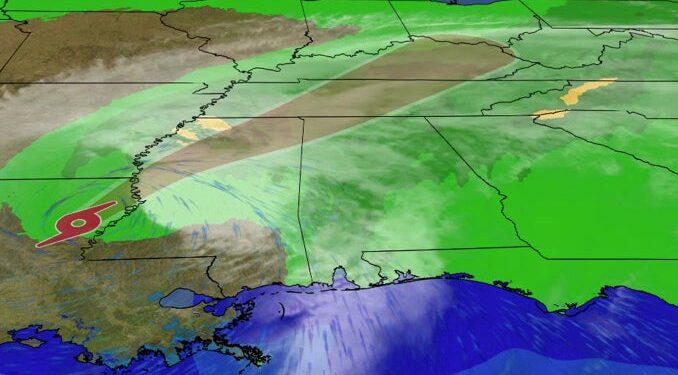Crédito: fuente
- Delta will track inland over the South this weekend as it continues to weaken.
- Locally heavy rainfall and gusty winds will affect the region.
- A few tornadoes are also possible.
Tropical Storm Delta will continue to weaken as it tracks across the South this weekend, where it will bring locally heavy rainfall, gusty winds and a few tornadoes.
Happening Now
Delta is centered over northeast Louisiana right now and is moving north-northeast at just over 15 mph.
Rainfall associated with Delta is affecting a broad area from the lower Mississippi Valley into parts of the Southeast.
NOAA’s Storm Prediction Center has issued a tornado watch for southeast Mississippi, southwest and south-central Alabama and the western Florida Panhandle until 1 p.m. CDT.
Current Radar, Watches and Warnings
Maximum sustained winds are now on the decrease as Delta weakens over land. Gusty winds are still ongoing, however, from the northern Gulf Coast into the lower Mississippi Valley.
Forecast
Delta is expected to weaken to a tropical depression on Saturday and then become a remnant area of low pressure on Sunday.
A broad area from the lower Mississippi Valley into parts of the Southeast and mid-Atlantic will see rainfall from Delta this weekend. The rainfall could produce localized flash flooding in some areas.
Parts of the lower Mississippi Valley, Tennessee Valley and the southern Appalachians have the greatest chance of local flash flooding today.
The remnant moisture from Delta will also produce rainfall in the Northeast by Sunday night into Monday.
Delta could also produce isolated tornadoes this weekend.
Areas Alabama and the Florida Panhandle into western and north Georgia have the greatest chance of seeing a few brief tornadoes on Saturday.
Tornado Outlook
(Shaded on the map above is the likelihood of tornadoes, according to NOAA’s Storm Prediction Center. Note that not all categories apply for the severe weather risk on a particular day.)
Delta’s History
Tropical Depression Twenty-Six formed late Sunday evening to the south of Jamaica and then strengthened into Tropical Storm Delta on Monday morning, the 25th named storm of the 2020 Atlantic hurricane season.
Delta became the ninth hurricane of the 2020 Atlantic hurricane season on Monday evening.
Winds in Delta increased by 85 mph in the 24 hours ending 11:20 a.m. EDT Tuesday. That was more than double the criteria for the rapid intensification of a tropical cyclone, which is a wind speed increase of at least 35 mph in 24 hours or less.
The maximum sustained winds in Delta topped out at 145 mph (Category 4) on Tuesday as it tracked through the western Caribbean.
Delta’s rapid intensification was due to an environment of the highest ocean heat content anywhere in the tropical Atlantic basin, low wind shear and sufficiently moist air, in a region notorious for rapid intensification in October, according to Sam Lillo, a NOAA scientist based in Boulder, Colorado.
Delta’s tiny size also helped it intensify so rapidly.
(MORE: Delta Was the Fastest on Record to Intensify From Tropical Depression to Category 4)
Delta made landfall Wednesday morning around 5:30 a.m. CDT near Puerto Morelos, Mexico, in the Yucatan Peninsula, with maximum sustained winds of 110 mph, making it a Category 2 hurricane.
Delta’s Landfall In Mexico
A wind gust to 75 mph was measured at Puerto Morelos, 64 mph in Cozumel and 106 mph on an elevated WeatherFlow observing site near Cancún.
(NEWS: Power Out, Trees Downed as Delta Strikes Yucatan)
Delta’s weakening prior to its Yucatan landfall appeared to be due to land interaction, some modest wind shear impinging on the hurricane from the east, inhibiting its outflow aloft, and also perhaps some dry air working into the tiny circulation.
Delta resumed strengthening as it tracked through the Gulf of Mexico later Wednesday into Thursday.
For the first time in Delta’s lifetime as a hurricane, a distinct eye finally cleared out in Infrared satellite imagery Thursday afternoon, and a U.S. Air Force Reserve Hurricane Hunter mission measured flight-level winds strong enough to warrant an upgrade to Category 3 status.
Delta weakened to a low-end Category 2 hurricane before reaching the Louisiana coastline east of Cameron, Louisiana, on Friday.
Delta made landfall near Creole, Louisiana, as a Category 2 hurricane with winds of 100 mph on Friday evening. That’s just 14 miles east of Cameron, Louisiana, where Hurricane Laura made landfall in late August.
Delta was the record 10th landfalling hurricane or tropical storm in the U.S. this season, which breaks the previous record of nine such landfalls in a season that had stood since 1916.
Delta was also the first hurricane with a greek name to make landfall in the United States.
It was also the fourth Louisiana landfalling storm of 2020, tying 2002 for the record most in any season in the Pelican State, according to Phil Klotzbach, Colorado State University tropical scientist.
Delta brought a significant storm surge, heavy rainfall and strong wind gusts to Louisiana and the southeast Texas coastline as it roared ashore.
Delta produced a 101 mph gust near the Texas/Louisiana border at Texas Point, Friday evening. Wind gusts over 75 mph were reported across much of southwestern Louisiana and extreme southeastern Texas.
Other significant wind gusts include:
- 96 mph in Lake Arthur, Louisiana (WeatherFlow station)
- 95 mph in Lake Charles, Louisiana
- 89 mph in Calcasieu Pass and Cameron, Louisiana
- 86 mph in New Iberia, Louisiana
- 78 mph in Port Arthur, Texas and Marsh Island, Louisiana
- 75 mph in Lafayette, Louisiana
- 74 mph in Pecan Island, Louisiana
Water levels spilled over the shoreline of the Gulf of Mexico as Delta made landfall. The water level at the Freshwater Canal Locks on the south-central Louisiana coast rose to at least 8.3 feet before the gauge stopped reporting, breaking the record for the location dating back to Hurricane Ike in 2008.
Other significant storm surge readings include:
- 5.52 feet in Calcasieu Pass, Louisiana
- 5.05 feet in Sabine Pass, Texas
- 1.46 feet in Lake Charles, Louisiana
- 0.94 feet in Port Fourchon, Louisiana
Flash flood emergencies were issued Friday evening where Delta’s eyewall created torrential rainfall. A rain gauge near Iowa, Louisiana, reported more than 17 inches of rainfall. Lake Charles, Louisiana, received more than 12 inches of rain.
The Weather Company’s primary journalistic mission is to report on breaking weather news, the environment and the importance of science to our lives. This story does not necessarily represent the position of our parent company, IBM.










